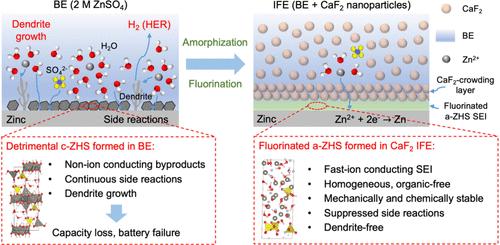将锌阳极上的有害结晶氢氧化锌硫酸盐转化为均相氟化无定形固态电解质间相
IF 16
1区 材料科学
Q1 CHEMISTRY, MULTIDISCIPLINARY
引用次数: 0
摘要
锌阳极上非离子导电副产物的形成对水锌离子电池(AZIBs)的危害是众所周知的。在此,我们成功地通过悬浮在稀硫酸电解质中的CaF2纳米颗粒诱导的非晶化和氟化,将具有代表性的有害副产物结晶氢氧化锌硫酸锌(ZHS)转化为快速离子导电的固体电解质间相(SEI)。与广泛报道的表现出结构和化学不稳定性的非均相有机-无机杂化SEI不同,设计的单相SEI具有均相、机械坚固性和化学稳定性。SEI的这些特性有助于防止锌枝晶生长和减少长期循环过程中的容量损失。重要的是,基于这种sei形成电解质的AZIB全电池在3 A/g的充电电压为2.2 V的情况下,在20,000次循环中表现出优异的稳定性,没有短路和电解质干化。这项工作提出了在金属阳极上设计SEI的途径,并提供了相关SEI化学的见解。本文章由计算机程序翻译,如有差异,请以英文原文为准。

Transforming Detrimental Crystalline Zinc Hydroxide Sulfate to Homogeneous Fluorinated Amorphous Solid–Electrolyte Interphase on Zinc Anode
The formation of non-ion conducting byproducts on zinc anode is notoriously detrimental to aqueous zinc-ion batteries (AZIBs). Herein, we successfully transform a representative detrimental byproduct, crystalline zinc hydroxide sulfate (ZHS) to fast-ion conducting solid-electrolyte interphase (SEI) via amorphization and fluorination induced by suspending CaF2 nanoparticles in dilute sulfate electrolytes. Distinct from widely reported nonhomogeneous organic–inorganic hybrid SEIs that exhibit structural and chemical instability, the designed single-phase SEI is homogeneous, mechanically robust, and chemically stable. These characteristics of the SEI facilitate the prevention of zinc dendrite growth and reduction of capacity loss during long-term cycling. Importantly, AZIB full cells based on this SEI-forming electrolyte exhibit exceptional stability over 20,000 cycles at 3 A/g with a charging voltage of 2.2 V without short circuits and electrolyte dry-out. This work suggests avenues for designing SEIs on a metal anode and provides insights into associated SEI chemistry.
求助全文
通过发布文献求助,成功后即可免费获取论文全文。
去求助
来源期刊

ACS Nano
工程技术-材料科学:综合
CiteScore
26.00
自引率
4.10%
发文量
1627
审稿时长
1.7 months
期刊介绍:
ACS Nano, published monthly, serves as an international forum for comprehensive articles on nanoscience and nanotechnology research at the intersections of chemistry, biology, materials science, physics, and engineering. The journal fosters communication among scientists in these communities, facilitating collaboration, new research opportunities, and advancements through discoveries. ACS Nano covers synthesis, assembly, characterization, theory, and simulation of nanostructures, nanobiotechnology, nanofabrication, methods and tools for nanoscience and nanotechnology, and self- and directed-assembly. Alongside original research articles, it offers thorough reviews, perspectives on cutting-edge research, and discussions envisioning the future of nanoscience and nanotechnology.
 求助内容:
求助内容: 应助结果提醒方式:
应助结果提醒方式:


